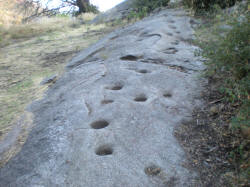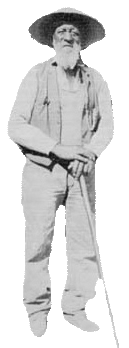Deep, well-worn
bedrock mortars and metates in Doane Valley are reminders of those
many centuries when Luiseño Indians maintained seasonal villages,
hunted game and gathered acorns and other seed crops here on the
slopes of Palomar Mountain.
 The village sites and ten smaller,
temporary camps or gathering stations have been identified within
the present-day park. At least two separate groups of Luiseños are
known to have established exclusive territories on the mountain. The
area around Boucher Lookout was called T’ai. Iron Springs near
Bailey Lodge was called Paisvi. Other areas were known as Chakuli,
Malava and Ashachakwo. These areas were used during the summer and
early autumn for hunting and gathering acorns, pine seeds,
elderberries and grass seeds. The village sites and ten smaller,
temporary camps or gathering stations have been identified within
the present-day park. At least two separate groups of Luiseños are
known to have established exclusive territories on the mountain. The
area around Boucher Lookout was called T’ai. Iron Springs near
Bailey Lodge was called Paisvi. Other areas were known as Chakuli,
Malava and Ashachakwo. These areas were used during the summer and
early autumn for hunting and gathering acorns, pine seeds,
elderberries and grass seeds.
The main Luiseño village at the
foot of the mountain was called Pauma. Sturdy conical houses known
as wikiups or kecha kechumat were made of pine poles covered with
bark. Semi-subterranean “sweat houses” were centrally located in the
village and used for purification and curing rituals. Handcrafted
products included clay jars, woven baskets, throwing sticks, nets
for fishing or carrying, bows and arrows and a variety of utensils
for cooking and eating.
The Luiseños called this
mountainous area Wavamai, but when the Spaniards arrived in the 19th
century, they named it Palomar, or “place of the pigeons,” a
reference to the thousands of bandtailed pigeons that nested in the
area. In 1798 Mission San Luis Rey was established four miles
upstream from the mouth of the San Luis Rey River. Pines and firs
from Palomar Mountain were used in its construction. An outpost, or
assistencia, was established at Pala in 1816. Father Antonio Peyri,
the Franciscan missionary at Mission San Luis Rey from 1798 to 1832,
spent several weeks each year working with the Indians who lived in
or near what is now Palomar Mountain State Park. He was persuasive
and soon came to be greatly loved, but the mission way of life both
here and elsewhere in California had some terrible effects on the
Luiseños. The sudden and complete disruption of age-old living
patterns, as well as the introduction of European diseases, quickly
resulted in a severe decline in the population. The mission was
closed down in 1834 when Governor Figueroa issued direct orders to
“secularize” all of the California missions. Today many descendants
of the mission period Luiseños live on nearby reservations and
continue to follow the Catholic religion though they also maintain
some of their earlier cultural and religious beliefs and practices.
In 1846 the slopes of
Palomar Mountain were included, at least theoretically, in the
famous Warner Ranch. In 1851, however, the Indians drove Warner off
the land. For a time thereafter, cattle and horse thieves used the
remote mountain meadows of Palomar to shelter their stolen animals until it was safe to take
them across the border into Mexico.
Palomar to shelter their stolen animals until it was safe to take
them across the border into Mexico.
Nathan Harrison, a black slave who
came to California during the gold rush, took up residence as a free
man near the eastern edge of the present park in the 1860s. He grew
hay and raised hogs in Doane Valley despite frequent trouble with
bears and mountain lions. At the time of his death in 1920, he was
said to be 101 years old. The old road from Pauma Valley is named in
his honor.
George Edwin Doane came into the
area in the early 1880s and built a shake-roof log cabin in the
little clearing between Upper and Lower Doane Valley in what is now
the Doane Valley Campground. Doane grew hay and raised cattle and
hogs on his 640 acres of meadowland, and some of the apple trees he
planted survive to this day.
During the southern California land
boom of the 1880s and afterward, many other people also settled on
Palomar Mountain. Four apple orchards within the park date from this
period, as do the remains of Scott’s cabin on Thunder Ridge. Palomar
Mountain State Park was created during the early 1930s, when 1,683
acres of what has been called “the most attractive part of the
mountain” was acquired for state park purposes. Matching funds for
this acquisition were provided by San Diego County and a group of
public-spirited citizens known as the Palomar Park Association. Many
of the roads, trails and picnic facilities that are in use to this
day were built during the 1930s by the Civilian Conservation Corps.
|